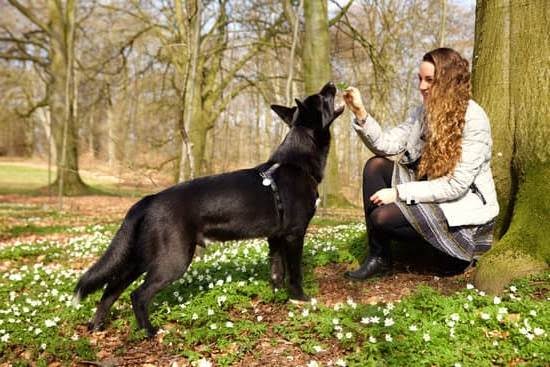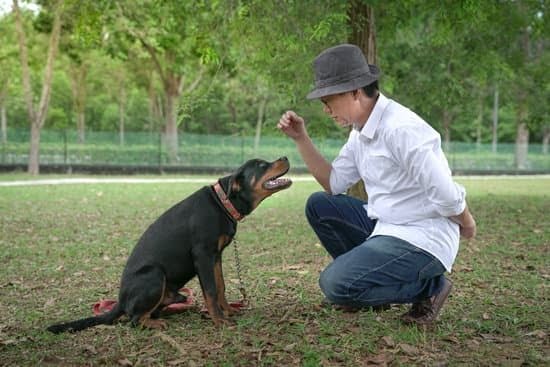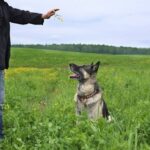Introduction
Training a dog to follow you is an incredibly beneficial task, as it gives them the opportunity to explore their environment while being led by an experienced individual – that’s you! Most dogs can be taught basic commands such as sit, stay, and come, but teaching them to follow you everywhere requires a bit more work. With the right approach and commitment, however, any dog can learn this skill! Here are some tips on how to train your pup to follow you:
1. Start indoors and move outdoors: Training your pet in an indoor environment first is very important since it’s confined and easier for them to focus on the task at hand. Acclimate your pup gradually with small practice sessions and progress from indoors to outdoors. For instance, start by practicing walking around furniture then transition outside around trees and other obstacles in your backyard or local park.
2. Use rewards: Using treats as rewards will help motivate your pup to stay focused on following you. Throw a few treats throughout the session to keep your dog happy and motivated during training.
3. Establish rules: Dogs respond well when given direction so make sure you set hard boundaries as part of the training process. Clear rules should be established so that they know exactly what behavior expects of them when they’re supposed to follow you; things like staying close or not pulling ahead are all very important principles that need reinforcing over time.
4. Demonstrate leadership : It’s also important that you show leadership throughout training otherwise they might not understand who’s leading them or why they should bother listening in return! Showing assertiveness through consistent yet gentle guidance is key if you want your pup to become better at following you wherever you may go!
By using these tips, you can provide your furry friend with the benefits of being trained to follow you anywhere – whether it’s outdoor walks with family or trips in public places like parks or beaches – it will open up wonderful possibilities for enriching activities together!
Establishing Boundaries
Before you can teach your dog to follow you everywhere, it is important to first establish boundaries through positive discipline. This means teaching your dog the rules of your house and proper behavior. Proper disciplining includes verbal commands (“sit”, “come”) as well as physical corrections (leash pulling, pointing a finger). Make sure to reward the desired behaviors with treats or praise to reinforce the lessons. Do not forget to also punish negative behavior in order for your pup to learn what not do do.
Creating a Routine: Establishing Habits
Once boundaries have been established with your pup, it’s time to create a routine. Each day, try setting up times when you and your pup go for walks together or play with toys in backyards; this establishes an expectation and creates habits over time. The more consistent these activities are done at the same times each day, the better sense of structure your dog will have. Alongside these interactive excursions, provide plenty of resources like toys and kibble that promote healthy physical and mental stimulation even when you’re away from home.
Promoting Bonding: Strengthening Your Relationship
Finally, spending quality one-on-one time with each other helps strengthen the bond between you and your pet significantly. Snuggle up together on the couch so they know it doesn’t always have to be about structured activities – forming a strong relationship can simply come from being near each other and being comfortable around one another. With enough trust and love between two people (and one pup!) comes an innate understanding that a pup will want nothing more than their companion close by all the time – meaning it won’t be long till they follow you everywhere!
Setting the Foundation
Before attempting to train your dog to follow you everywhere, it is important to set a firm foundation by teaching your pooch basic obedience commands. Gradually introduce each command or skill, such as sit, stay, come and leash walking, as well as socialization exercises like meeting other people and animals. As your pup learns and masters new skills, reward them with treats or praise for their hard work. All of this will lay the groundwork for your dog to confidently and comfortably follow you anywhere you go.
Implementing Positive Reinforcement
Teaching your dog to follow you everywhere may seem like a daunting task, but it doesn’t have to be! Positive reinforcement is one of the most effective methods of training and rewarding your pup for following commands. Start by giving your pet verbal recognition when they respond correctly. For example, say “good dog” or “well done” after your pup has completed the task you asked. If you want further encouragement, consider offering treats and/or praise every time they perform the requested behavior. When dealing with something as important as this command, always make sure that you shower plenty of puppy love and extra attention whenever necessary! Additionally, you can practice having your dog stay closely behind you while walking. Give them verbal cues like “heel” or “follow me” every few steps to remind them to stay close by so they learn that this type of behavior is desired. Throughout the process remain patient yet persistent; with enough practice, consistent rewards and repetition your pup will be following you around everywhere in no time!
Utilizing Clicker Training
Clicker training is one of the best methods for teaching a dog to follow you everywhere. It is an effective way for both the owner and the pet to understand what actions will lead to rewards. To begin clicker training, it’s important that you use the same sound every time your pet performs a desired action. This can be done with a clicker or even with a sound of your making such as a special whistle or phrase. When your dog responds correctly, reward him or her immediately afterward by giving a treat or some other form of positive reinforcement.
Additionally, you could incorporate verbal cues into your clicker training routine in order to help your pet learn which behaviors are desirable and which are not. For instance, when introducing basic commands such as “sit” and “come”, be sure to verbalize them each time you use the clicker. As your pet become better at associating the appropriate behavior with these commands, gradually introduce more complex tasks such as walking close beside you in heel position and responding quickly when called from far distances. Encourage obedience through treats after successful performances each time while increasing the difficulty as necessary so that both you and your pooch get plenty of mental stimulation during this process.
Establishing Trust
The first step in establishing a bond of loyalty with your dog is creating trust. Establishing trust between you and your pup should begin from day one and take time and patience. You’ll want to introduce yourself slowly, give them treats, hug and pet them carefully so they can become used to you. When introducing new things like toys or food, reward them with positive reinforcement when they respond favorably. Give them enough space to explore without feeling overwhelmed or anxious.
Also, it’s important to set boundaries that align with the desired behavior. It’s also important to provide your dog with consistent interaction that reinforces positive traits such as obedience and loyalty. Give plenty of praise when they do right and use both physical gestures (like hand signals) or verbal commands (like “sit” or “stay”) for instruction where appropriate. Be sure to keep the training sessions short but interactive so that your pup stays engaged and learns quickly. Whenever possible take the time for play in addition to teaching commands during a training session as this establishes a strong relationship among you two which is at the core of successful training
Avoiding Negative Reinforcement
When teaching a dog to follow you, it is important to use positive reinforcement rather than negative reinforcement. Negative reinforcement is an approach that establishes undesirable behavior through punishment and can lead to additional behavioral issues in the future. Additionally, it causes fear which can be a barrier to learning. Instead, reward-based training that utilizes positive reinforcement will encourage desired behaviors and help build trust between you and your pup. Here are some tips:
• Always reward your pup with treats or affection when they follow you and act properly, avoiding punishing them for mistakes
• Use positive commands such as “come” or “heel” when teaching them how to walk beside you
• Keep your training consistent; repetition will help your pup learn quicker
• It is essential to keep each training session short and fun for both of you before taking breaks so that it does not become tiresome
• Avoid confusing your pup with too many commands all at once; introduce these gradually over time to increase their comprehension
• Begin by letting them explore an area while on a leash; then start encouraging proper behavior and movements when they obey simple commands
Combining Reinforcement and Exercise
One of the best ways to train your dog to follow you anywhere is to incorporate regular exercise routines into your dog’s day. Exercise is a great way to both tire out an overly energetic pup and help your pooch become familiar with the noises, sights, and smells they will encounter when you take them places. Include plenty of walks in new environments as part of their everyday routine, so that they can become comfortable with anything from riding in cars to visiting the pet store.
Furthermore, reinforcing good behavior during these excursions is essential for success. Encourage your dog when they stay close and listen to your commands no matter what environment you are in. Treats can be a great form of positive reinforcement for listening and staying close. On the other hand, verbal warnings followed by a time-out or redirection back towards good behavior are also effective — this lets your pup know which behaviors are acceptable and which ones are not. After successful outings, don’t forget to reward them with extra treats or praise! Teaching good behaviors while out in public helps set the groundwork for later on down the line when you want them by your side no matter where you go!
Preparing For Busy Environments
Being able to take your pet with you everywhere can be a great way to socialize them and keep them from becoming anxious in unfamiliar environments. The key to achieving this is for your pet to trust that you are the pack leader, and follow a consistent set of rules. Start by taking walks around busy places such as parks or shopping malls on quieter weekdays where there are still plenty of people around; use the same kind of leash you’d use for everyday obedience training. Praise your dog for staying close, even if it may be tempting for them to approach others. Allow them small interludes and let them sniff new scents or enjoy time away from you when appropriate, but never forget that the goal is always to get your dog back right next to you afterwards.
For more advanced training, look into attending obedience agility classes at local pet stores or DogPlay workshops held in larger cities. There’ll be lots of stimulating sights and sounds- which will mimic being surrounded by other animals and people – plus distractions such as jumping over obstacles – that will require your dog’s full attention as well as subsequent reinforcement from you when they complete tasks correctly. Over time, teaching your canine companion how to focus on their handler amidst a backdrop of excitement will mean success in crowded and noisy environments such as cafés or parks with lots of children running around playing games!
Building Consistent Routines
Training your dog to follow you everywhere requires consistency and dedication from both you and your pet. A crucial part of this process is developing consistent routines that give your dog an opportunity to practice their skills with you. These activities can include daily obedience training sessions, such as sit, stay, lie down, come when called, leave it and heel. Start small, with just a few commands per session. Ensure that the training sessions are fun for both of you by providing rewards for tasks that are done correctly. This will make them look forward to participating in future training sessions, and follow the commands more readily since they have positive associations associated with them. As they improve (and they will!), add more complex commands during each session or increase the area or length of time that they must remain in heel position – just don’t forget to reward them when they do it correctly!
Troubleshooting Issues
If you encounter any issues while trying to train your dog to follow you everywhere, the first step is to identify what type of behavior is causing the issue. Common examples include pulling on the leash, not responding to commands or getting distracted easily. Understanding the issue helps you determine what approach may be needed to address it.
When changing unwanted behaviors, it’s always best to use positive reinforcement like treats and praise when your dog does something right. If your pup is unresponsive to commands such as sit or stay, utilizing a clicker can help reinforce desired behaviors. For distractions, try rewarding them with treats every time they focus attention on you instead of wandering off. Utilizing a shorter leash and avoiding open areas can also limit their ability to wander away from you.
Another useful tool for training are crate games which uses crates as an obstacle course where the dog has to navigate through in order for them to get a reward at the end of it. This helps reinforce needed behaviors such as come and stay by teaching them mental fortitude. Finally, introducing trick based training can also help keep your pup’s attention more consistently as they stay engaged through fun tricks and enjoy being rewarded for successfully completing them.
Conclusion
A well-trained dog can enrich your life in many ways. They will follow you wherever you go and are more likely to behave around guests and other animals. Additionally, they’ll be easier to take out in public, reducing stress when visiting unfamiliar places. Training your dog is also a great way to form a bond with them and build trust. Ultimately, training your pup will yield multiple benefits for you and your four-legged companion.

Welcome to the blog! I am a professional dog trainer and have been working with dogs for many years. In this blog, I will be discussing various topics related to dog training, including tips, tricks, and advice. I hope you find this information helpful and informative. Thanks for reading!





